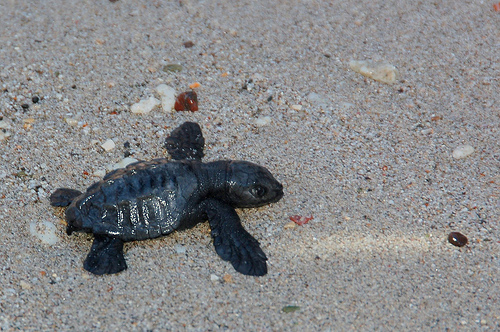

Location: Limon province Map
Area: 78,000 acres (31,198 hectares)
Turtle National Park also known as Las Baulas National Marine Park is located in the Limon province on the Western, Pacific coast of Costa Rica. Turtle National Park covers an area of 78,000 acres (31,198 hectares). This nature reserve contains several biospheres including wetlands, jungles, beaches and marine ecosystem. However the most interesting feature of the Turtle National Park is largest nesting colony of leatherback sea turtles. Thousands of these majestic animals come here every year to lay their eggs.
The importance of the Las Baulas National Marine
Park aka Turtle National Park, from the point of view of
conservation and also the main tourist attraction, lies in the
nesting of the leatherback turtle on the beaches of these protected
areas, being Playa Grande its main spawning ground, In a 7000 km
journey in a biological marine corridor that includes Costa Rica as
a spawning site, then the Galapagos Islands in Ecuador (where they
return to continue the journey, but do not spawn) and finally, South
America, where the route branches off. Playa Ventanas and Playa
Langosta also come with leatherbacks, but they are closed to public
observation, since there are research programs in them: there are
biologists counting eggs and monitoring the nests.
The
leatherback turtle is the largest chelonian in the world and is in
critical danger of extinction, according to the Convention for
International Trade in Endangered Species of Flora and Fauna
(CITES). The threats to the subsistence of the species are multiple:
from being accidentally caught by fishermen in the Pacific Ocean,
the use of their meat, their eggs and other products of the turtle
by the same humans or animals, coastal real estate development,
pollution and climate change.
Since 1980, the first official
count of leatherback turtles that nested in Playa Grande (about
200), by biologists from Drexel University and Indiana Purdue
University, has been made, the number of these reptiles has been
decreasing progressively year after year: in 1996-1997 only 128 were
recorded; in 2006, 124; in 2007, 58; 15 in 2009, 52; in the
2010-2011 season, 33, equal to what was reported to March 2012 for
the 2011-2012 season, that is, in the last 27 years 90% of the
world's leatherback population has been lost.
The fight for
the protection of leatherback habitat began in 1988 with Maria
Teresa Koberg, who organized the boy scouts, students and friends of
the area to help in the prevention of the theft of leatherback
turtle eggs, organizing a vigorous campaign to protect the area by
decree and then by law. The same neighbors who in their past were
"hueveros" - people who loot turtle eggs - are now guides that show
how the process occurs.
The first sightings of the turtles
begin at the beginning of October, considering October 20 as the
"official date" of the beginning of the mating and nesting season.
However, in 2005, 2008 and 2011 an unusual nesting of a leatherback
turtle was observed in the month of June in Playa Grande.
The
leatherback turtles nest at intervals of 9 to 10 days, deposit an
average of 5-7 clutches per year, place about 60 eggs per laying,
every 3.7 years.7 The turtles come out, make the "bed", open a
hollow, they lay their eggs, cover it, camouflage it and then leave.
This lasts between one and two hours. After 60 days of incubation,
the eggs hatch and the new offspring begin their march towards the
sea, where they will not be seen again until adulthood. After the
nesting they migrate towards the south, looking for the waters near
Galapagos, due to the impact of the Humboldt current.